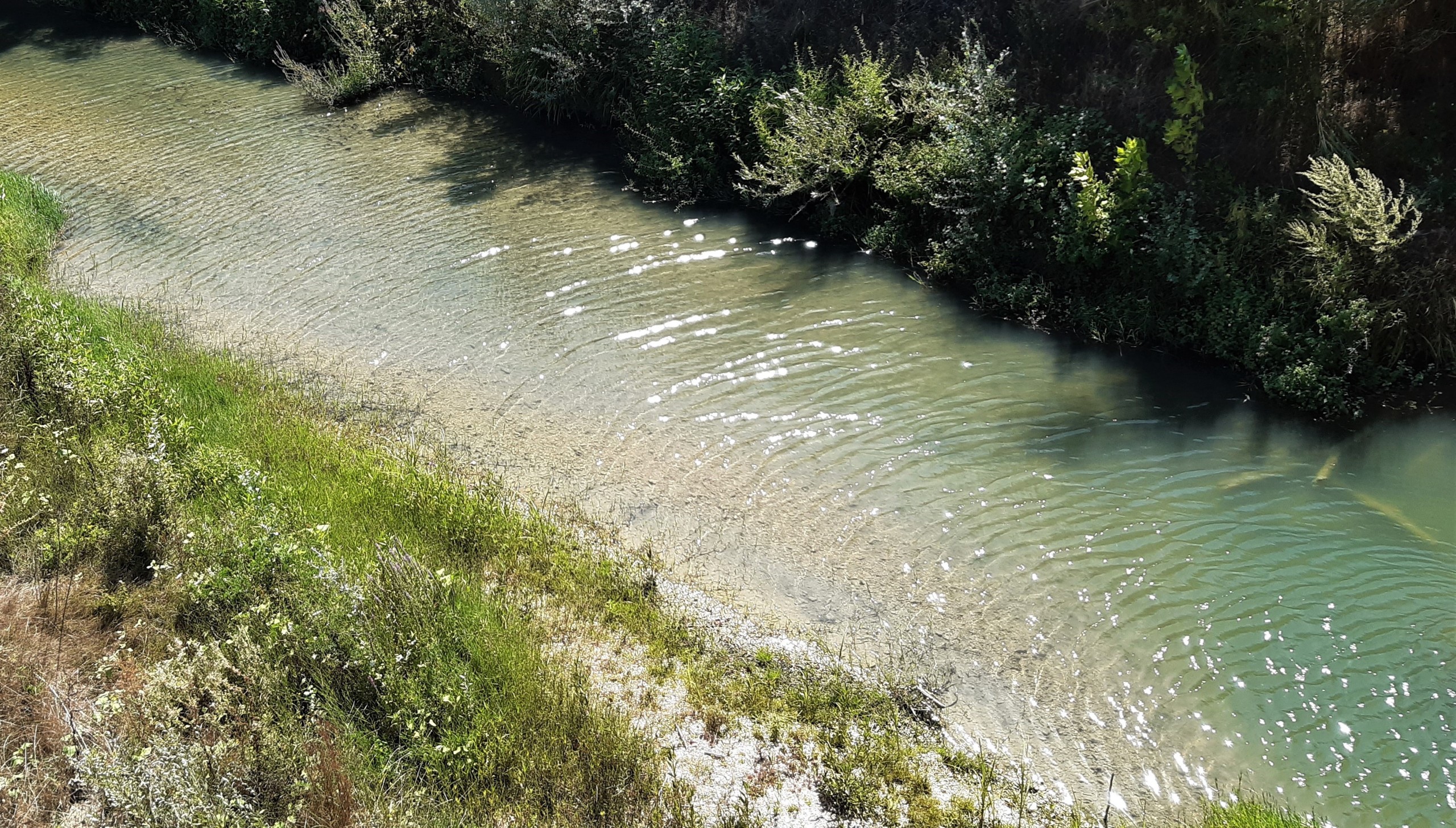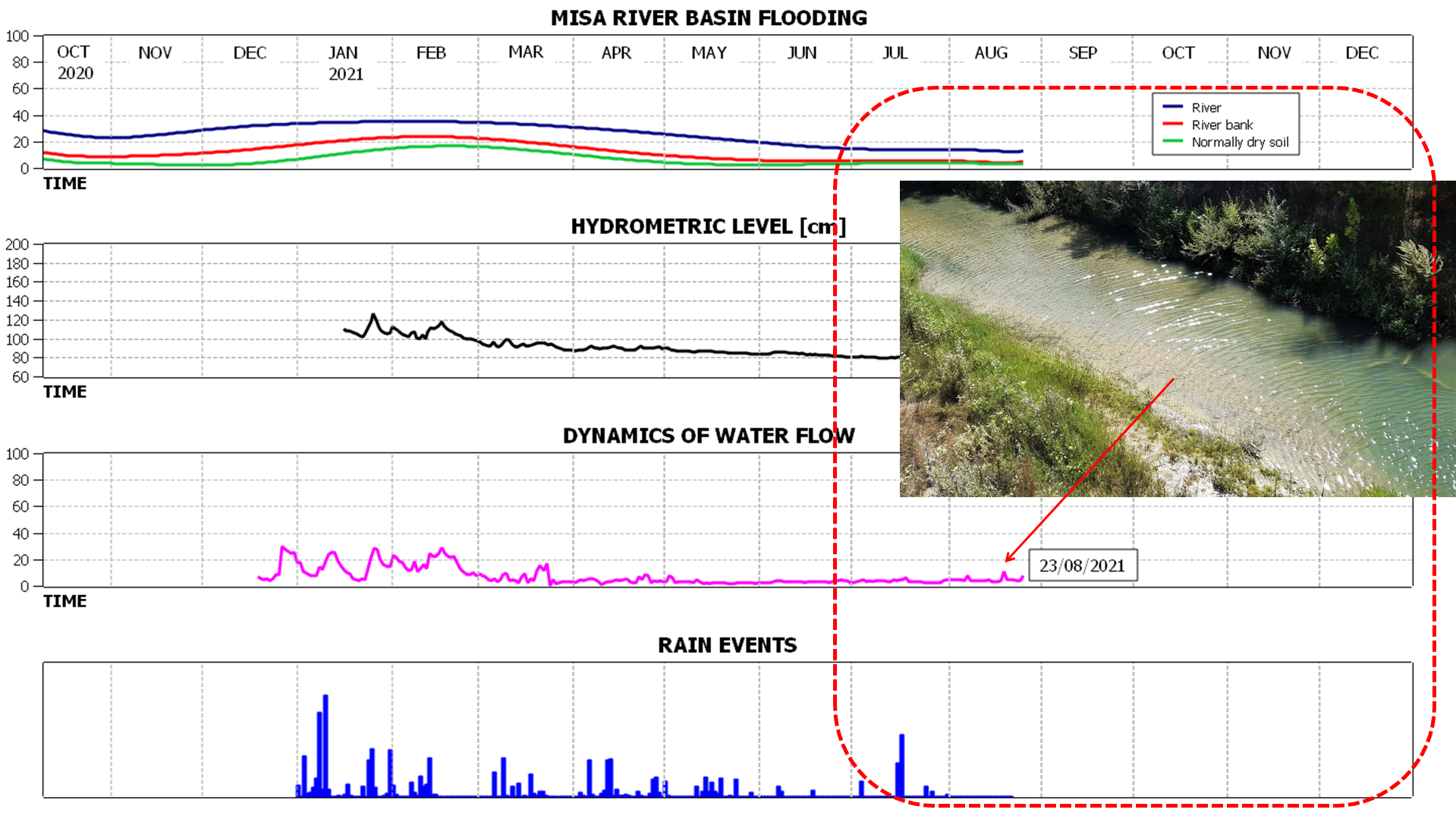Acque mosse dal vento…
Valutare la dinamica del flusso d’acqua.
Valutare la dinamica del flusso d’acqua.
Il fiume Misa durante il mese di agosto in una giornata ventosa: il livello delle acque è minimo, caratterizzato da piccole onde e increspature che si presenta alla nostra strumentazione come una superficie riflettente scabrosa, continuamente variabile, che diffonde la radiazione elettromagnetica in tutte le direzioni.

L’ambiente fluviale del Misa è sorvegliato con un innovativo sistema di monitoraggio che visualizza la percentuale di allagamento del bacino e le perturbazioni atmosferiche locali per osservare come varia nel tempo il suo stato. Si utilizza strumentazione originale di natura passiva: speciali radiometri a microonde ricevono la radiazione elettromagnetica naturale emessa dall’ambiente e stimano la quantità di acqua libera e di umidità presenti in superficie, quindi, la percentuale di allagamento del bacino fluviale e le sue variazioni stagionali.
Questi dati sono completati con misurazioni che valutano la dinamica delle acque.
Quando un radiometro a microonde osserva una superficie in movimento come un flusso di acqua, la radiazione proveniente dall’atmosfera e dall’ambiente riflessa verso lo strumento si diffonde in tutte le direzioni con intensità variabile (scattering) e si registrano importanti fluttuazioni nella potenza di segnale misurata, dipendenti dalla velocità, dalla turbolenza delle acque, dalle caratteristiche del terreno e dalla conformazione del territorio (pendenza), dall’incremento della portata dovuto a piogge e dal vento che modificano la variabilità e l’irregolarità della superficie.

Questi effetti sono ben evidenziati dall’andamento della traccia di colore rosa nel grafico che mostra le variazioni stagionali della dinamica del flusso d’acqua. Un ovvio incremento nella velocità e nella turbolenza delle acque si osserva durante il periodo invernale e primaverile, caratterizzato da copiose e frequenti piogge che incrementano notevolmente il livello e la portata del fiume. Al contrario, il flusso è relativamente stazionario durante la stagione estiva, molto secca data la scarsità di precipitazioni. Durante il mese di agosto, tuttavia, occasionali picchi di segnale possono verificarsi durante le giornate particolarmente ventose che agitano il corso d’acqua con piccole onde e increspature, come evidenziato sul grafico. La sensibilità della strumentazione è tale da segnalare questi eventi con ottimo contrasto rispetto al regime marcatamente stazionario delle acque, tipico di questo periodo.
Waters moved by the wind…
Evaluating the dynamics of the water flow.
Evaluating the dynamics of the water flow.
The Misa river during the month of August on a windy day: the water level is minimal, characterized by small waves and ripples that presents itself to our instrumentation as a rough, continuously variable reflective surface, which spreads electromagnetic radiation in all directions .

The river environment of Misa is monitored with an innovative monitoring system that displays the percentage of flooding of the basin and the local atmospheric disturbances to observe how its state varies over time. Original passive instrumentation is used: special microwave radiometers receive the natural electromagnetic radiation emitted by the environment and estimate the amount of free water and moisture present on the surface, therefore, the percentage of flooding of the river basin and its seasonal variations.
These data are complemented with measurements that evaluate the dynamics of the waters.
When a microwave radiometer observes a moving surface such as a water flow, the radiation coming from the atmosphere and the environment, reflected towards the instrument, spreads in all directions with variable intensity (scattering) and important fluctuations in the power of measured signal are detected, depending on the speed, the turbulence of the water, the characteristics of the terrain and the conformation of the territory (slope), the increase in the flow rate due to rain and wind that modify the variability and irregularity of the surface.

These effects are well highlighted by the trend of the pink trace in the graph that shows the seasonal variations of the dynamics of the water flow. An obvious increase in the speed and turbulence of the waters is observed during the winter and spring, characterized by copious and frequent rains that significantly increase the level and flow of the river. On the contrary, the flow is relatively stationary during the summer season, which is very dry due to the scarcity of rainfall. During the month of August, however, occasional signal peaks may occur during particularly windy days that shake the watercourse with small waves and ripples, as shown on the graph. The sensitivity of the instrumentation is such as to signal these events with excellent contrast to the markedly stationary regime of the waters, typical of this period.

